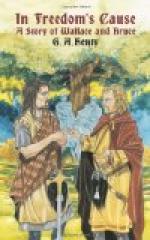It was in the spring of 1311 that this important capture took place. Bruce, as usual, had the castle levelled to the ground. Bunnock was rewarded by a grant of land which still bears his name, softened into Binney. Again the English made preparations for a renewed invasion, but the barons were too much occupied by their private broils and their quarrels with the king to assemble at his order, and nothing came of it. Bruce’s position at home was so established that he resolved upon a counter invasion, and accordingly, having assembled a larger force than had hitherto gathered under his banner, crossed the Border near the Solway, burnt and plundered the district round Gilsland, ravaged Tynedale, and after eight days’ havock returned with much booty to Scotland. In the following month he again entered England, carried fire and sword through the country as far as Corbridge, swept Tynedale, ravaged Durham, and after levying contributions for fifteen days returned with much booty to Scotland.
Although the English made much outcry at this invasion, the English author of the Chronicle of Lanercost, whose monastery was occupied by the king during the raid, distinctly states that he slew none save in actual conflict; and again, that though “all the goods of the country were carried away, they did not burn houses or slay men.” Thus, though Bruce’s wife and daughter were still prisoners in England, though his brothers had been executed in cold blood, he conducted his warfare in England in a manner which contrasts strongly indeed with the conduct of the English in Scotland.
After this Bruce marched north again and laid siege to Perth. For six weeks he invested the town, but without making any impression. Then he retired his forces as if abandoning the attempt. At night, however, he returned, ladders were placed in the ditches against the walls, and with his knights he led his followers on to the assault. The garrison were carousing in honour of their successful defence and the defeat of the enemy, and taken wholly by surprise were unable to oppose a vigorous resistance, and all were killed or captured. Some accounts say that the English soldiers were made prisoners, and the renegade Scots fighting with them were put to the sword; while others affirm that all who were taken prisoners were spared.




